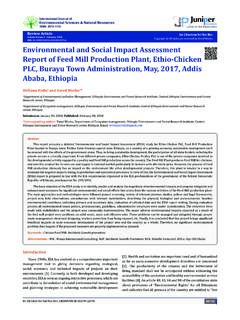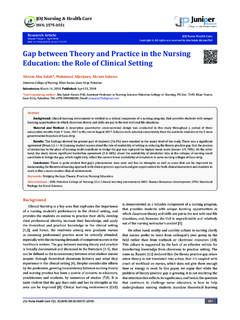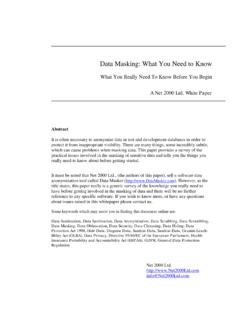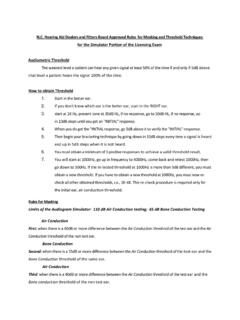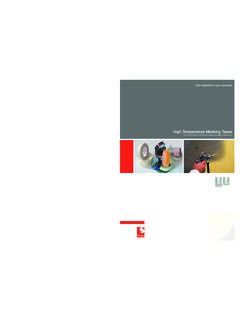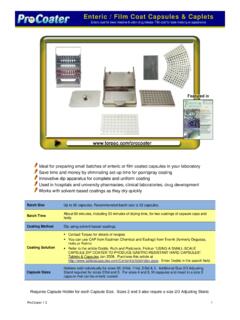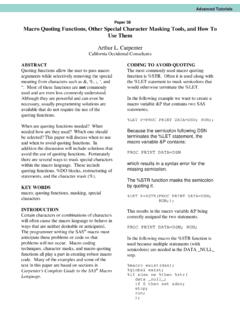Transcription of Masking Level Difference (MLD): Literature Review
1 Review Article Volume 5 Issue 1 - March 2017 DOI: J OtolaryngolCopyright All rights are reserved by Patricia da Silva de Paula Masking Level Difference (MLD): Literature ReviewPatricia da Silva de Paula *, Silvana Maria Monte Coelho Frota and Lilian Felipe Master in Speech Therapy by Veiga de Almeida University, Speech-Language Pathologist by Fluminense Federal University, South America PhD in Human Communication Disorders by Sao Paulo Federal University. Professor at Rio de Janeiro Federal University, South America Post Doc Maastricht University - The Netherlands.
2 PhD in Health Sciences Minas Gerais Federal University. Coordinator and Chair Professor at Fluminense Federal Univesity, South AmericaSubmission: February 20, 2017; Published: March 10, 2017*Corresponding author: Patricia da Silva de Paula, Master in Speech Therapy by Veiga de Almeida University, Speech-Language Pathologist by Fluminense Federal University, South AmericaGlob J Otolaryngol 5(1): (2017)0016 IntroductionHearing is a fundamental meaning to life, because it is the basis of human communication allowing the insertion of the individual in society.
3 The auditory system allows the processing of acoustic events whose function is to select speech sounds over competitive factors such as noise [1-10]. The auditory processing refers to the efficiency and effectiveness with which the central nervous system (CNS) uses auditory information. It is the basis for complex actions such as understanding spoken language, not being a closed process, interacting intimately with other neural systems and being influenced by experience, environment and active training; its alteration affects negatively the quality of life of many people [11].
4 Among the central auditory functions that comprise auditory processing, we find temporal processing and binaural interaction. It is highlighted that temporal auditory processing is especially important in speech perception, discrimination of subtle clues, recognition of phonemes and their distinctive features and discrimination of similar words. On the other side, binaural interaction is described as a process that allows the integration or separation of stimulus related to inter-hemispheric cooperation.
5 The binaural interaction is evaluated through two main behavioral procedures: the Binaural Fusion and Masking Level Difference (MLD) tests [12-21].Because it is part of the evaluation of binaural interaction, the Masking Level Difference (MLD) deserves to be highlighted because of its importance, justifying this Literature Review . In performing the MLD, peculiarities concerning the performance of the test must be well known in order to avoid mistakes in the interpretation of the result. The main objective of this Review was to describe the central aspects regarding the achievement, interpretation and clinical utility of MLD [22-26].
6 MethodThis Review was carried out through the search of the subject descriptors Masking Level Difference , MLD , Masking and Auditory Processing , Temporal Processing in the Virtual Global Journal of OtolaryngologyISSN 2474-7556 AbstractMasking Level Difference composes a tests set for the central auditory processing behavioral evaluation and estimates decoding binaural interaction abilities. MLD test consist of auditory Level measurement by emitting a pulsatile clear tone to both ears, at the same moment as a masker rustle is being emitted.
7 This work has the objective of reviewing Literature over MLD, providing general information concerning to the test. Binaural Interaction Tests evaluate central auditory nervous system (CANS) on processing dissimilar information, but complementary, emitted to both ears. The rustle has the objective of Masking the auditory signal, in a permanent stage. On that test, the individual is submitted simultaneously to an auditory signal and to a rustle. However, emitting a rustle to the other ear becomes the auditory sign more audible. MLD is a psychological/auditorial phenomenon, in which detection or recognizing a binaural or monoaural sign emitted, is improved adjoining a competitive binaural rustle.
8 An individual is normally evaluated at the same stage (speaking, pulsatile tone, masker rustle in both ears) and in a different stage (one of the signs is emitted to 180 C [356 F] in a diverse way from the initial one, just to one ear, while the other one is kept in a reverse stage). The test allows identifying individuals with compromised low : Masking Level Difference ; MDL; Masking Auditory ProcessingHow to cite this article: Patricia d S d P, Silvana M M C F, Lilian F. Masking Level Difference (MLD): Literature Review . Glob J Oto 2017; 5(1): 555655.
9 DOI: Journal of OtolaryngologyHealth Library (BVS) databases, including articles in English and Portuguese languages, published from 1982 to 2010. From this primary selection, scientific papers and medical books were selected and added. Literature ReviewCentral Auditory ProcessingSpeech perception involves the experiences of the individual during his life and the importance he or she attributes to the auditory stimulus; these aspects involved in this process are not dependent only on the peripheral and central auditory system.
10 Auditory processing involves, besides the auditory discrimination, the abilities of localization and lateralization of the sound, recognition, temporal aspects, tests of dichotic listening and with degraded acoustic signals. Auditory discrimination involves the perception of acoustic stimulus in very fast sequences requiring accuracy of the information that is brought to the brain, consequently enabling the decoding and understanding of speech mainly in unfavorable situations, such as with the presence of background noise and competitive speech [27-34].
